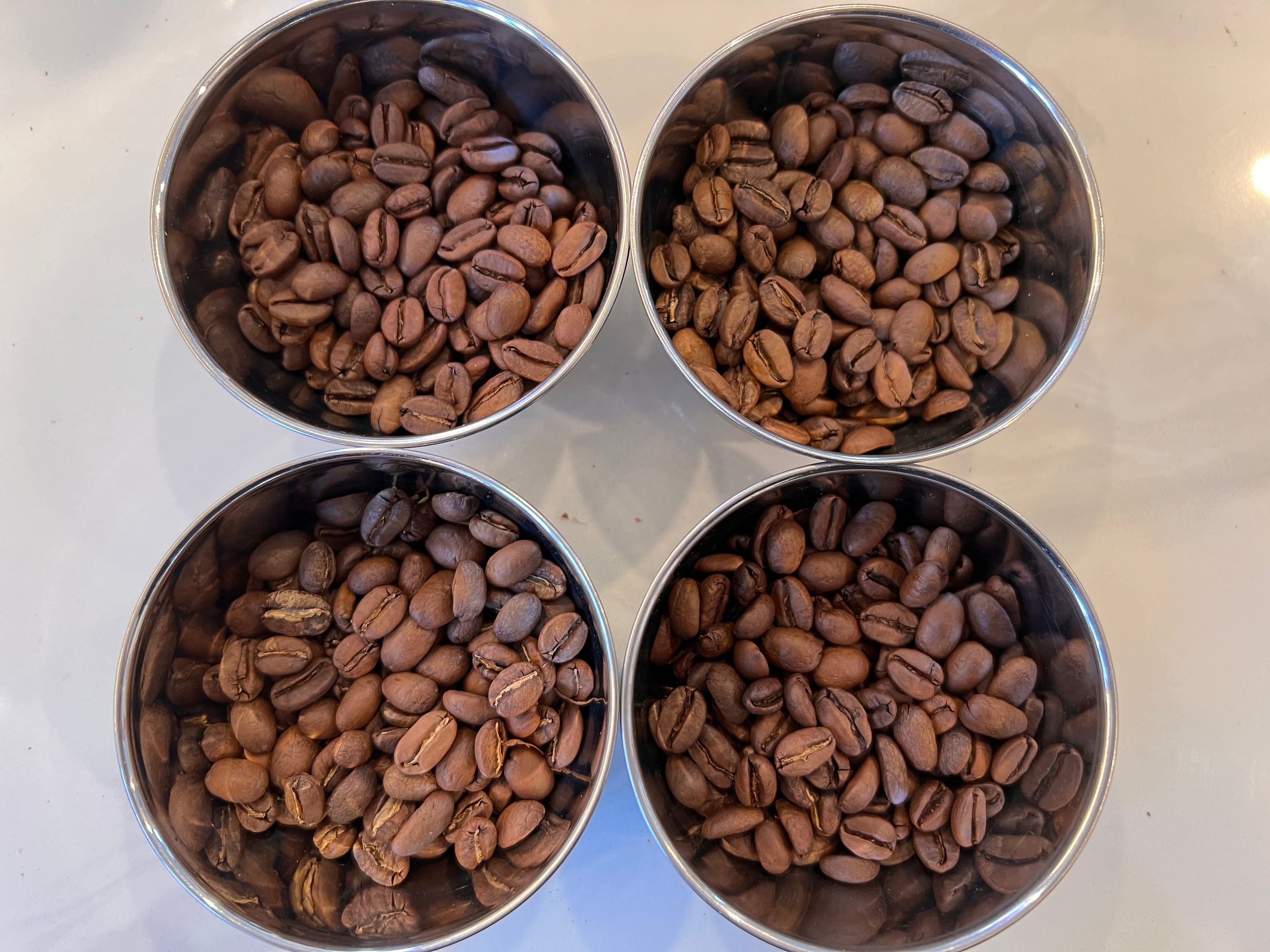Coffee Processed Six Different Ways for Espresso | by Robert McKeon Aloe | Jun, 2022
Coffee Data Science
Natural, Honey, Wet, Carbonic Maceration, Sourdough Yeast, and Anaerobic
I have always been curious how the coffee cherry processing affects the taste of the roasted coffee. However, I didn’t think it would be possible to experiment without befriending coffee farmers. Luckily, I befriended Hiver van Geenhoven at Chromatic Coffee, and we started chatting.
Hiver had been working with a farm for a number of years producing Parainema coffee. He happened to have multiple processing variants of the same coffee cherries, and he gave me some samples. At first, he gave me Natural, Honey, Washed, and Carbonic Maceration. I combined leftover green beans and yeasted them in sourdough. Later, he gave me a sample of anaerobic processed beans.

They all roasted similarly, and I dropped them at a similar development time. Post-roast, their densities ranges from 0.365 g/ml to 0.387 g/ml, so by density, they had about the same densities.




Espresso Machine: Decent Espresso Machine
Coffee Grinder: Niche Zero and Fellow Ode with SPP Burrs
Coffee: Home Roasted Coffee, medium (First Crack + 1 Minute)
Shot Preparation: Staccato Tamped and Staccato
Pre-infusion: Long, ~25 seconds
Infusion: Pressure Pulsing
Filter Basket: 20g VST
Other Equipment: Atago TDS Meter, Acaia Pyxis Scale
I use two metrics for evaluating the differences between techniques: Final Score and Coffee Extraction.
Final score is the average of a scorecard of 7 metrics (Sharp, Rich, Syrup, Sweet, Sour, Bitter, and Aftertaste). These scores were subjective, of course, but they were calibrated to my tastes and helped me improve my shots. There is some variation in the scores. My aim was to be consistent for each metric, but some times the granularity was difficult.
Total Dissolved Solids (TDS) is measured using a refractometer, and this number combined with the output weight of the shot and the input weight of the coffee is used to determine the percentage of coffee extracted into the cup, called Extraction Yield (EY).
I was surprised to find similar performance amongst the first four (natural, honey, washed, and carbonic maceration). In terms of TDS/EY, there were no standouts, good or bad. There was a single Natural processed shot that I had ground too coarse, and I consider that an outlier.

I sorted the shots by method and taste score across the time aligned shots. There is not a trend in EY. There were fewer Anaerobic and Yeast shots.

In taste, there is also not a trend aside from anaerobic being a clear winner.

I cut these scores another way by averaging the individual taste metrics across all the shots in a category. This showed a little bit more nuance, specifically, the yeast processed had better scores for sweet, sour, and bitter. I suspect if I had more data for yeast, it would be more distinguishable than the rest.

Additionally, Honey and Washed do slightly better on bitterness than Natural and Carbonic Maceration.
Coffee Data Science
Natural, Honey, Wet, Carbonic Maceration, Sourdough Yeast, and Anaerobic
I have always been curious how the coffee cherry processing affects the taste of the roasted coffee. However, I didn’t think it would be possible to experiment without befriending coffee farmers. Luckily, I befriended Hiver van Geenhoven at Chromatic Coffee, and we started chatting.
Hiver had been working with a farm for a number of years producing Parainema coffee. He happened to have multiple processing variants of the same coffee cherries, and he gave me some samples. At first, he gave me Natural, Honey, Washed, and Carbonic Maceration. I combined leftover green beans and yeasted them in sourdough. Later, he gave me a sample of anaerobic processed beans.


They all roasted similarly, and I dropped them at a similar development time. Post-roast, their densities ranges from 0.365 g/ml to 0.387 g/ml, so by density, they had about the same densities.




Espresso Machine: Decent Espresso Machine
Coffee Grinder: Niche Zero and Fellow Ode with SPP Burrs
Coffee: Home Roasted Coffee, medium (First Crack + 1 Minute)
Shot Preparation: Staccato Tamped and Staccato
Pre-infusion: Long, ~25 seconds
Infusion: Pressure Pulsing
Filter Basket: 20g VST
Other Equipment: Atago TDS Meter, Acaia Pyxis Scale
I use two metrics for evaluating the differences between techniques: Final Score and Coffee Extraction.
Final score is the average of a scorecard of 7 metrics (Sharp, Rich, Syrup, Sweet, Sour, Bitter, and Aftertaste). These scores were subjective, of course, but they were calibrated to my tastes and helped me improve my shots. There is some variation in the scores. My aim was to be consistent for each metric, but some times the granularity was difficult.
Total Dissolved Solids (TDS) is measured using a refractometer, and this number combined with the output weight of the shot and the input weight of the coffee is used to determine the percentage of coffee extracted into the cup, called Extraction Yield (EY).
I was surprised to find similar performance amongst the first four (natural, honey, washed, and carbonic maceration). In terms of TDS/EY, there were no standouts, good or bad. There was a single Natural processed shot that I had ground too coarse, and I consider that an outlier.

I sorted the shots by method and taste score across the time aligned shots. There is not a trend in EY. There were fewer Anaerobic and Yeast shots.

In taste, there is also not a trend aside from anaerobic being a clear winner.

I cut these scores another way by averaging the individual taste metrics across all the shots in a category. This showed a little bit more nuance, specifically, the yeast processed had better scores for sweet, sour, and bitter. I suspect if I had more data for yeast, it would be more distinguishable than the rest.

Additionally, Honey and Washed do slightly better on bitterness than Natural and Carbonic Maceration.
